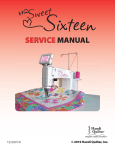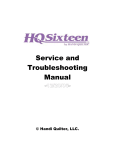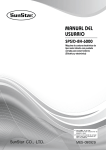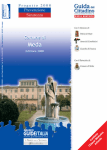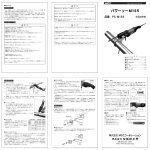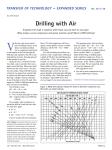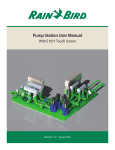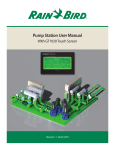Download HQ Fusion Service Manual WEB.indd
Transcript
SERVICE MANUAL Designed by a Quilter, for Quilters.® 5/12/09 © 2009 Handi Quilter, Inc. Table of Contents About the HQ Fusion (I) About the Manual (I) Service Manual General Rules (I) General Specifications (II) Assembly Torque Specifications (III) Lubrication Specifications (IV) Adjustments: Section Lubrication Instructions………………………………………………..……………….0 General Observation of Front Frame Cover, Mast and Hand Wheel ………….............1 Removal of Front Cover ……………………………………………………………….2 Securing Flats and Screws……………………………………………..……………….3 Axial Play Check and Adjustment..…………………………………………………….4 Adjusting the Base Plate ……………………………………………………………….5 Adjusting the Motor Drive / Timing Belt Tension……………….…………………….6 Adjusting the Presser Bar Height / Presser Foot………………………………………..7 Needle Position, Check, & Adjustment…………………………………………...........8 Adjustment of the Loop Lift and Needle Distance…..…………………………………9 Adjusting Needle Height………………………………………………………………10 Adjustment of the Stop Finger …………………………………………………..…….11 1 About the HQ Fusion Quilting Machine The HQ Fusion™ utilizes high-tech electronics and an innovative touch-pad user interface to offer greater functionality and ease of operation to home quilters than ever before conceived in the quilting industry. The HQ Fusion™ quilting machine is a high quality machine that incorporates very robust design features and is very easy to service. The HQ Fusion™ machine is constructed following a specific sequence of operations similar to the construction of a house. Walls cannot be erected until the foundation is in place. Similarly, this service manual has been written with an adjustment logic that is driven by the construction processes used to create the machine. If the service technician carefully follows the adjustment steps in the order presented, a fine running sewing machine is possible each and every time. About the Manual The purpose of this service manual is to help the technician complete a repair on a machine accurately and quickly. The manual is complete with photographs and explanations that we hope will aid you in your repair efforts. In addition to the teaching aids found herein, you will also find all of the tools listed that are necessary for adjustments. If you need help in locating these tools for purchase, please contact Handi Quilter. Handi Quilter’s Customer Service technical staff is available for assistance and advice during normal business hours. For additional help in technical training, we refer you to the training schedule at the Corporate Office in North Salt Lake, Utah. Service Manual General Rules • Adjustments shown in the manual should only be made if a setting deviates from the tolerance specified in the manual. • Adjustments should be made only in the logical sequence shown and described in the manual. (Do not jump ahead or start in the middle of the adjustment sequence – this may cause additional or more serious problems than the original issue.) • Safety must be considered when working on any machine. Safety warnings are included throughout this manual where appropriate, but these warnings do not address all possible safety concerns that might confront the service technician. • When working on or near any live electrical assemblies, the power cable must be removed from the machine. • We urge you to observe the cautions in the manual. • Please note that the hand wheel must always be turned in the direction of normal rotation unless otherwise instructed. This is especially true when making the loop lift timing and needle height adjustment. (Exceptions are removing thread locks or testing belt tension – the handwheel may be rocked forward and reverse in these cases) 2 HandiQuilter.com Page 3 General Specifications Sewing Opening Dimensions: Sewing Speed: Needle System: Needle Sizes, (recommended): Hook System: Bobbin Type: Bobbin Case: Motor Type: Needle Positioning: Electrical Power: LED Power Consumption: Sew Foot Stroke/Lift: Needle Bar Stroke: Take-Up Stroke: Lubrication, (main components): Lubrication of hook: Page 4 (245mm X 610mm) 9.625” X 24” Manual Mode: Min 110spm, Max 2200spm Regulated Mode: Min 0spm, Max full speed 134 (135 X 7) 12/80 - 20/125 (Rotary, custom made, Cerliani, Type FA, Vertical, M Bobbin) Aluminum, Class M Cerliani, Type MF Brushless DC, internal encoding Up/down, half stitch, walking stitch 90 – 264 VAC, 47-63Hz, 400W peak 15 W 5 mm 35.3 mm 73 mm (Kluber Lube, permanent) (Velocite 10, Texaco 22) 3 HQ Fusion Service Manual Assembly Torque Specifications The Torque Specifications apply to all internal and external fasteners in sizes 4.0, 5.0, and 6.0mm in general at ISO 4762 Screw class 8.8. The torque specifications are also generally classified as soft jointed and are listed according to size and placement in the machine. 1. 4 mm Allen Socket Head Cap Screws, Class 8.8 @ 2.5Nm (uses 3mm Allen tool) • Head-frame, Bearing retainers, Front cover small 2. 4mm Allen Set Screw, Class 8.8 @ 1.2 Nm (uses 2.0mm Allen tool) • Tension assembly, 3 hole thread guide, Motor pulley 3. 5mm Allen Socket Head Cap Screw Class 8.8@ 5.6Nm (*uses 4mm Allen tool) • *Front cover large • Belt Tensioner (flat head screw - uses 3mm Allen tool) 4. 5mm Allen Set Screw, Class 8.8 @ 2.4 Nm (uses 2.5mm Allen tool) • Main shaft timing pulley, Hook shaft timing pulley, Collars, Front handwheel 5. 6mm Allen Socket Head Cap Screws Class. 8.8 @ 9.9Nm. (uses 5mm Allen tool) An exception must be observed here since the screws are considered soft jointed and shallow threaded and are used externally. It is therefore advised that this torque specification not exceed 6Nm. • Drive train bracket, Base Plates 6. 6mm Allen Set Screw, Class 8.8 @ 4.5 Nm (uses a 3mm Allen tool) • Rear Handwheel HandiQuilter.com 4 Page 5 Lubrication Specifications Rep Lube Kit Part# QM49262 Lubricant type Machine Components #1. Kluber, Constant OY68 (Red) #2 Kluber, Mikrozella G 8 OY (Blue) #3. Kluber, GLY 2100 (Yellow) #4. Kluber, NCA 15, Isoflex #5. Kluber, GLY 151, Polylub (Green) (Orange) #6. Conoco, Hydroclear R&O 32 (Purple) or similar white oil, i.e. Texaco 22, or Velocite 10 All main bearings Not used on HQ Fusion Machine Take-up lever, articulating link, and needle bar driver Take-up caged needle bearings Presser bar guide and plunger, lifting link, and pitman eccentric Hook race HQ Lubricant Order Numbers #1 Red OY 68 #2 Blue Mikrozella G 8 OY #3 Yellow GLY 2100 #4 Green IsoFlex NCA-15 #5 Orange GLY 151 #6 Purple Texaco 22, hook race only All the above in box w/ booklet Replacement Lube Replacement Lube Replacement Lube Replacement Lube Replacement Lube Replacement Lube Rep Lube Kit Box #1 Red: #2 Blue: #3 Yellow: #4 Green: #5 Orange: #6 Purple: #1-#6 Kit QM49301 QM49302 QM49303 QM49304 QM49305 QM49306 QM49262 The HQ Fusion lubricating schedule should be followed every year up to every two years to insure top mechanical performance. Page 6 5 HQ Fusion Service Manual The HQ Fusion lubricating schedule should be followed every year up to every two years to insure top mechanical performance. Lube #1 (Red), between the bearing and the shaft at the 9 places shown. Apply one drop of Lube #6 (Purple), to the raceway of the bobbin case support two to three times per day. This application is based upon sewing for 8 hours of machine time. If the machine is used less, lubricate the hook less frequently. After the lubrication of the hook, it is recommended that one momentarily sew on scrap material before resuming the sewing of the quilt. Failure to do so may result in oil stains on the quilt piece. 6 HandiQuilter.com Page 7 5 #1 (Red) OY 68 One drop on the side of the needle and presser bars. (2 places) 3 3 4 4 5 #3 (Yellow) GLY 2100 One drop per orifice, articulating link, take up lever, and needle bar driver (3 places) 5 #4 (Green) IsoFlex NCA-15, inside caged needle bearings (2 places) 5 3 #5 (Orange) GLY 151 Add grease sparingly to the presser bar slide and plunger. Add a small amount between the stylus and cams of both the presser bar lifting link, and the hopping mechanism lifting arm. (4 places) 1 1 Page 8 7 HQ Fusion Service Manual 1. General Observation of the Front Frame Cover, Mast, and Hand Wheel The following observations, accompanied by necessary adjustments, will ensure trouble-free thread passage. Failure at any of these points will significantly affect thread tension. Check: 1. The Thread Mast should be adjusted so that the eyelet loops are centered directly over the spool pins. (Figure 1.1) If a correction is necessary: Loosen the jam nut, reposition and tighten the jam nut. (10mm open end wrench) 2. Figure 1.1 Check: Make sure that a gap of 1.0mm to 1.5mm exists between the frame and the hand wheel. (Note: The handwheel screw is inside the front cover and cannot be seen from the outside of the machine, therefore it can only be adjusted with the front cover removed ) (Figure 1.2) If a correction is necessary: (Usually this would only be necessary if the handwheel is rubbing, has an extreme gap or is loose) remove the front cover (see Section 2), loosen the hand wheel set screw, position the hand wheel and retighten the set screw. (3mm handle allen) 3. Figure 1.2 1 Check / Inspect: test the condition of the thread guides 1, 2, 3, 4, thread stirrup 5, thread guide 6, and needle bar thread guide 7 for any abrasions, cuts, or electroplating blistering. Test each guide by flossing it with thread, left to right and front to back in all directions, checking for any sharp defects that may damage or cut the thread. Replace any damaged parts. (Figure 1.3) (2mm and 2.5mm handle allen) 2 3 4 5 6 7 Figure 1.3 8 HandiQuilter.com Page 9 Figure 1.4 Figure 1.5 Check the top tension assembly for the following: llowing: Check between the tension discs for any foreign material that could prevent the discs from functioning properly. If a correction is necessary: Check the relative location of the knob before removing the knob. Remove the knob, detent washer, tension discs, and cone spring. Clear and reassemble. Note: on very rare occasions, if the machine has been used an extreme amount, it is possible for a groove to be worn into the tension discs. This will make it impossible for the tension to be adjusted correctly as the thread can pass thru this worn groove in the tension discs, while the unworn part of the discs touch, resulting in no tension on the thread in the groove. This may result in thread nests on the bottom of the quilt. The top tension assembly will need to be replaced in this instance. Top tension assembly part # QM10198 Check: that the take up spring has a normal torsion tension and inspect the spring for any cuts, breaks or abrasions. When moved by hand and released, it should return to the end of the cutout in the top tension assembly. If a correction is necessary: (2mm handle allen, #1 flat screw driver) (Figure 1.5) Loosen the set screw under the top tension assembly a couple turns as it fixed into an undercut into the top tension base. Note that the set screw is on about a 30° angle to the machine front cover. Loosen the slotted set screw at the rear of the top tension base and rotate the split bolt until the spring returns to the end of the slotted groove when pushed and released. If the take up spring needs replacement remove the tension parts and split bolt and carefully work the spring around until it can be removed. Replace with a new take up spring – part # QM10197. Make sure the split bolt is inserted all the way into the base and retighten the slotted screw. Reinstall the top tension parts on the split bolt and then the assembly into the machine front cover and tighten the set screw – see below for the radial position of the top tension assembly. When the top tension assembly is properly installed into the machine front cover, the straight part of the take up spring (before the loop) will be straight up at 12 o’clock (or toward 11 o'clock). Check that the top tension knob is not too loose on the split bolt and that it has some resistance so that it will not vibrate loose while sewing. If a correction is necessary: To correct: remove the knob, detent washer and cone spring, adjust the split bolt by spreading with a flat screw driver until the knob has adequate resistance to keep its setting. Caution: the split bolt is hardened and if adjusted too much it may break – the top tension assembly will then need to be replaced – Top Tension Assembly part # QM10198 9 Page 10 HQ Fusion Service Manual 2. Removal of the Front Cover Tools Required: 2mm, 3mm, 4mm handle allen, 4mm L allen, #3 flat screwdriver, and #2 philips screwdriver. A 1. Loosen the set screw A in (Figure 2.1), rotate the thread guide 3 to allow access to the frame screw, then re-snug the screw so the guide will not become misplaced. (2mm handle allen tool) Figure 2.1 2. Remove the three frame screws as shown in (Figure 2.2.) (3mm handle allen) Figure 2.2 3. Before removing the C-pod, use a grounding mat and wrist strap. Connect the two ground clips to the bare threads of the hopping foot. (Figure 2.3) Caution: make sure the machine is unplugged from the wall before removing the C-pod or whenever working on the machine. Figure 2.3 4. Remove the “C-pod” by unscrewing the 4 screws (Figure 2.4) (#2 Philips screwdriver) Figure 2.4 10 HandiQuilter.com Page 11 5. With the machine properly grounded and with a ground wrist strap, carefully unplug the cables from the C-pod. Be careful not to touch the C-print or damage the cables or plugs. They should be pulled straight out by the connector. (Figure 2.5) Note: the plugs are labeled and keyed on the C-pod circuit board. Figure 2.5 Motor (Figure 2.6), Motor Controller Board (Figure 2.7), Motor Encoder (Figure 2.8), and Cables Figure 2.7 Figure 2.6 Page 12 Figure 2.8 11 HQ Fusion Service Manual Fusion P-Pod and Cables Fusion C-Pods and Cables Figure 2.9 Figure 2.10 CAUTION - - DANGER OF ELECTRICAL SHOCK – DANGEROUS VOLTAGES. Do not plug in main power or run the sewing machine with the p-pod off of the machine and or open so that human body part comes in contact with electrical energy. Note 1: The C-Pod and the P-Pod are STATIC SENSITIVE parts and should not be handled without special discharge tools. For this reason, all C and P Prints will be exchanged in the pod covers. Do not remove the Printed Circuit Boards (PCBs) from the pods. Note 2: The plugs are labeled and keyed on the C-pod circuit board. Note 3: After installing the cables through the service hole on the front cover, carefully take out any excess cable through the hole and fold inside of the pod covers. This will prevent any pinching or subsequent damage to the cables by moving parts. 12 HandiQuilter.com Page 13 6. Remove the needle plate. (Figure 2.11). (#3 flat screwdriver) Figure 2.11 Figure 2.12 Figure 2.13 7. Loosen both the two front and three rear base plate screws a couple turns to allow the front cover to be removed. (Figures 2.12 and 2.13) (Tools needed: 5mm handle Allen wrench) 8. Remove the 7 frame screws in (Figure 2.14 and 2.15) Note: The seventh screw is behind the C-print removed in step 4. (4mm handle allen – may need 4mm L allen tool to break loose screws) Figure 2.15 Figure 2.14 9. Separate the Front Frame Cover. Make sure the take up lever does not get caught in the frame slot. Important Note: the take up lever is very hard and will break, not bend 13 Page 14 HQ Fusion Service Manual 3. Checking and Securing Flats and Screws The HQ Fusion has been designed using flats and special screws to help prevent loop lift timing from slipping, except at the hook (if the hook cannot slip then something has to break when something goes wrong.. The hook is designed to be adjusted without removing the front cover.) Check the following locations, making sure that the first screw of a timed component has been fixed firmly on the respective flat on the shaft: Pitman 1st screw The Pitman crank (Figure 3.1) (3mm handle allen), the main shaft thrust collar (Figure 3.2) (2.5mm handle allen), the main shaft timing pulley (Figure 3.3) 2.5mm handle allen), and the hook shaft timing pulley (Figure 3.4) (2.5mm handle allen). Note: The screws are generally positioned 120 degrees apart. When the first screw (Position 1) has been located and tightened on a flat, the second screw is then tightened, compounding the tightness of the first screw, thus securing and assuring that timing will not change. Note: the main shaft collar is a long collar with two in line screws, the left screw, nearest the bearing, is on the flat, the right screw is on the shaft. Figure 3.1 Note: See torque specifications chart in the specification section for torque values. Collar inclined flat Figure 3.2 Note: The thrust collar flat is inclined. The first screw(left) (shown in Figure 3.2) must be provisionally tightened. The second screw(right) is then fully tightened. The first screw(left) is then fully tightened. It is important to check that this collar tightening procedure did not create a tight arm shaft condition. If so, readjust the collar again until there is no tightness and minimal to no end play. This is checked by rotating the shaft and checking a few times thru a full 360° rotation of the shaft. Position 1 120 o Position 2 Main Shaft Timing Pulley Figure 3.3 HandiQuilter.com Direction of rotation FIRST SCREW, FIRST POSITION RULE: The first screw or first position is ALWAYS located 120° apart in the direction of rotation from the second screw or second position. 14 Page 15 Checking and Securing Flats and Screws (Continued) Hook shaft timing pulley - (2.5mm handle allen) Note: the hook shaft timing pulley rotates the opposite direction as the main shaft timing pulley – carefully note the labeled first screw (Figure 3.4) Note: the hook shaft collar does not have a flat – the flat is located on the hook shaft timing pulley 1st screw. Hook Shaft Timing Pulley 1st screw Figure 3.4 Important hook shaft notes: The hook shaft turns two times per stitch and rotates in the opposite direction as the main shaft. Please carefully note which screw is the first screw in the direction of motion and on the flat. The hook shaft gear is set to a specific setting from the end of the shaft to allow proper needle to hook distance adjustment. Adjust the collar to remove axial play, not the hook shaft gear, or the setting can be thrown off which may make it so needle to hook distance can not be adjusted. The HQ Fusion utilizes long collars with two screws in line to help prevent the collar from tipping when tightened causing variation of tightness or play as the collar rotates 360º. To insure no tightness or play the collar should be checked through a full rotation until it has minimal tightness and minimal play. 15 Page 16 HQ Fusion Service Manual 4. Axial Play Check and Adjustment Axial or end play on shafting can result in noise, wear, and faulty sewing. Tools required: (2, and 2.5mm handle allen) Check: 1. Check the arm-shaft by pushing and pulling on the hand wheel. (Figure 4.1) Note: a small amount of main shaft axial play is permissible. Too much main shaft play, however, may cause noise and or stitching issues. If a correction is necessary: Figure 4.1 • • • • • • Remove the front cover. Loosen the thrust collar screws (Figure 4.2) Adjust so that minimal to no play is detected. Care must be taken on the first screw that is fixed on an inclined flat so as not to tighten too tight at first. Provisionally set the left screw nearest the bearing first, tighten the second screw fully tight. Tighten the first screw. Check that the shaft has minimal play and no tightness from the collar being too tight. Collar set screws Figure 4.2 2. Check the hook shaft by pushing and pulling the hook as shown in (Figure 4.4). If a correction is necessary: • • Remove the front cover. Remove the play by loosening the hook shaft thrust collar (not the hook shaft timing pulley) and adjusting out any axial play. (Figure 4.3) Note: there is no flat for the hook shaft thrust collar. Figure 4.4 Collar set screws 16 Figure 4.3 HandiQuilter.com Page 17 5. Adjusting the Base Plate Feet and Rollers Tools required: (5mm handle allen) Check: 1. The Base Plate must be adjusted so that the rubber feet, or the wheels as applicable, will sit flat on a planed surface. Note: this is done on a precision surface plate at the factory during assembly. If a correction is necessary: thin shim washers may be used as shown in (Figures 5.1 and 5.2). Figure 5.1 Figure 5.2 Adjustment of Base Plate Rollers: Check: The base plate rollers must be equally spaced in their respective positions. Using a tape measure or a 16”or longer ruler check that the front and back wheels are equal distance on both sides of the machine. (Figure 5.3) If a correction is necessary: • Slightly loosen the front base plate screws. (Figure 5.4) • Shift the front base plate until the front and rear wheels are equidistant on both sides. Figure 5.3 17 Figure 5.4 Page 18 HQ Fusion Service Manual 6. Adjusting the Motor Drive/Timing Belt Tension The HQ Fusion machine utilizes a single motor drive/timing belt system. Tools required: (3mm handle allen) Check: With the machine front cover removed. Check the belt tension for tautness by pressing it with the index finger (Figure 6.1). Press the vertical center of the belt with approximately 2 lbs of pressure. The belt should deflect about ½”. Proper belt tension provides for some belt flexibility under light finger pressure, but should not be so tight as to bind the machine. Double check the tension by rotating and rocking the handwheel. Confirm that there is no backlash or play between the belt teeth and any of the driven components. Confirm also that there is an immediate transfer of motion to all components driven by the belt. Important: Do not over tighten the belt as this will make the machine too tight and difficult to turn and may cause other undesirable issues. If a correction is necessary: • Insert a 4mm handle allen tool through the hole in the main frame casting (Figure 6.2). Loosen the belt tensioner screw. Adjust the belt tensioner by pressing down on the tensioner and tightening the belt tensioner screw. Figure 6.1 Figure 6.2 Main Timing Belt 18 HandiQuilter.com Page 19 7. Adjusting the Presser Bar Height (Tools required: 3 mm handle allen, 0. 5mm feeler gauge, 8mmopen end wrench) Figure 7.3 • • • • Figure 7.4 • Check: When the needle bar is in its lowest position, the sewing foot should be no higher than 0.5mm above the needle plate as shown in (Figure 7.3). It is permissible for the sewing foot ring to lightly touch the needle plate. Note: the factory default is for the presser bar (not the jam nut) to be about 1.5” above the needle plate with the needle in the lowest position. In this position the foot should be screwed into the presser bar about 14 or 15 revolutions. Check the foot without removing it by looking to see that there are about 10 or 12 threads of the foot exposed below the hopping foot jam nut. It is important to check this before resetting the presser bar height in case the end user has changed the foot height. Improper setting of the presser bar height and foot height can cause stitch problems, including skipped stitches. If a correction is necessary: Turn the handwheel until the needle bar is at its lowest position. Place the (0.5mm feeler gauge Part # QM40133) under the hopping foot. (Figure 7.3) Loosen screw C through the machine front cover (3mm allen driver) (Figure 7.4, 7.5) Wiggle the presser bar up or down to the desired position. Tighten screw C - push down lightly on the tool blade towards the table while tightening. This will insure the hopping block mechanism contacts the appropriate lifting lever and eccentric. Confirm the ring of the foot is centered on the needle when the screw is retightened. 7 c. Adjusting the Presser Foot (Sewing Foot) Screw “C” Figure 7.5 The HQ-Sixteen features the “KinetiQuilt” hopping mechanism, allowing the sewing foot to move (hop) up, down, and dwell on the fabric when the needle is in the fabric. This allows fabric to move through the machine similar to a normal sewing machine with a feed dog. The dwell time allows for a longer hesitation of the foot on the fabric and completion of the stitch cycle. The results are better tension, less needle breakage, and increased hook life. The foot should be no more than 0.5mm above the needle plate when the needle is in the lowest position. It is permissible for the foot to touch the needle plate. The end user may have adjusted the foot at the threads, this usually can be corrected as stated below. If a correction is necessary: Hold the foot, loosen the jam nut, screw the foot shaft to the desired height. Make sure the ring is centered on the needle, Tighten the jam nut – (8mm open end wrench). Note: ake sure you hold the foot while tightening and loosening the jam nut as shown (Figure 7.6) 19 Figure 7.6 Page 20 HQ Fusion Service Manual 8. Needle Position, Check, & Adjustment The needle position adjustment is the most important of all adjustments in the machine. Needle Position provides des the foundation for which all other settings are made. Once the needle position has been completed, great care must be maintained to keep this setting. It is important that the sewing machine be transported carefully, so as to not allow bumping or dropping. Check: • Use a new system 134 size 100, needle. Check the needle for straightness on a flat surface such as the needle plate. The needle must be centered in the stitch hole of the needle plate as shown in (Figure 8.1). (2mm and 3mm handle allen) Bobbin case end Figure 8.1 A Adjustment for Y axis: (Cover Off) B Note that adjustment is done with the front frame cover off. F If a correction is necessary: • Loosen first the screw D and screw F (Figure 8.2 ) • Loosen screw A and screw B in (Figure 8.2) While pushing the head frame back into the main casting, gently slide the head frame left or right to correct as necessary. • Tighten screws A and B in (Figure 8.2). Note: If needle position changes, repeat the process. Provisionally tighten screw D & F at this time. D Adjustment for X axis: (Cover On) F D Figure 8.2 F D E C F D Note that adjustment is done with the front frame cover on. Important Note: The picture shows the cover off for illustration purposes only! The primary adjustment is accomplished using the right side of the head frame shown in (Figure 8.3). The screws on the left side are loosened to allow movement of the head frame. If a correction is necessary: • Loosen screw F, and screw E 2 or 3 turns. • Loosen screw D 2 or 3 turns and back off screw C a little. • Push the head frame back against the main frame so that screw C touches the main frame. Adjust screw C to bring the needle to center in the needle plate. • Tighten screw D. Note: if the needle changes, repeat the process. • Tighten screw E until it gently touches the main frame, then tighten screw F. Note: If needle position changes, repeat the process Figure 8.3 20 HandiQuilter.com Page 21 9. Adjustment of the Loop Lift and Needle Distance Important note: The timing and needle distance adjustment must be done with the front machine cover on. “Loop Lift” is a universal hook and timing term for all lock stitch sewing machines. When the needle lifts a specified distance from the BDC (bottom dead center), the hook point is set to coincide with the needle as shown in (Figure 9.4 ) This is the radial position of the hook called “Loop Lift” commonly referred to as timing. Another part of timing is the “Needle Distance” This is the axial distance from the hook point to the needle. Loop lift is the radial setting of the hook and needle distance is the axial setting of the hook. Both of these are set on the hook and fixed with the same set screws. Since two things are being set at the same time, this can be a little difficult until practiced. Figure 9.1 Tools required: (loop lift clamp part # QM40199, 2.2mm forked feeler gauge part # QM40136, 2mm ball end L Allen wrench, 2mm handle allen, and a #3 flat screwdriver) NOTE: The loop lift clamp used must have a plastic protective compression pad, so as not to damage the coating on the needle bar. Figure 9.2 Figure 9.3 Check: (observe the following) • Remove the needle plate. • Turn the hand wheel until the needle bar is at its lowest position or BDC. • Place the loop lift clamp (with special protective compression pad) on the needle bar and set the thumbscrew lightly. • Place the 2.2mm feeler gauge between the clamp and the bottom of the head frame bearing surface (Figure 9.1). • Raise, reset, and tighten the clamp, pinching the 2.2 feeler gauge in between the clamp and projected bearing. This step may need to be repeated a few times to remove all excess play between the clamp and gauge. • Remove the 2.2 feeler gauge (Figure 9.2). • Rotate the hand wheel in the direction of motion, “Important” until the clamp lightly touches the gauging surface. (Figure 9.3). Important note: if if the handwheel is turned too hard the clamp may move, making the check invalid. • Check the position of the hook point relative to the needle. (Figure 9.4). • Check the distance between the needle and the hook point. It should be as close as possible. Ideally there will be less than .001” gap between the two. Too much needle distance or improper loop lift settings may cause shredding and or skipped stitches. Too little distance will cause the needle to bend during sewing and may cause other issues. 21 Figure 9.4 Page 22 HQ Fusion Service Manual 9. Adjustment of the Loop Lift and Needle Distance - Continued If correction of loop lift or needle distance is necessary then the basket must first be rotated down: Rotating basket down - Note: With the bobbin case basket in the normal position, the basket needle guard deflects the needle and makes it difficult to accurately adjust the needle distance between the hook point and the back of the needle scarf. It is important that the basket needle guard be rotated down out of the way to allow correct adjustment of the needle distance setting.(Figure 9.5) shows from below the stop finger engaged with the bobbin case installed. Figure 9.5 Stop finger engaged with bobbin case installed, as seen from below. (Figure 9.5) Stop finger engaged without bobbin case, as seen from above (Figure 9.6) Figure 9.6 Rotate the basket out of the way to facilitate the needle distance adjustment - Important: after moving the stop finger, you need to hold the basket in place when turning the hand wheel, to prevent the needle from hitting the basket. • Loosen the stop finger screw with the (2.5mm handle allen tool). • Slide the stop finger out of the basket groove, until the basket can be rotated. You may need to remove the stop finger – in this case don’t worry about reinstalling it until after you are finished with the timing adjustments. • Snug the stop finger screw. • Rotate the basket 180 degrees until large cutout is up towards needle as shown in (Figure 9.7) (you will now need to hold the basket in that position - see important note above) • Adjust needle distance (and loop lift). Basket rotated 180 degrees down, facilitating needle distance adjustment, as seen from above –(Figure 9.7) Figure 9.7 22 HandiQuilter.com Page 23 9. Adjustment of the Loop Lift and Needle Distance – Continued Note: If Figure 9.8 Needle guard Figure 9.9 Hook screws Figure 9.10 • • • • Thread cutters Figure 9.11 • • • • Hook screws w/o front cover Figure 9.12 Page 24 needle height is not set roughly close first, it will not be possible to set needle distance correctly. If a correction is needed: If still in place from the check - Remove the clamp. The basket must be rotated down in order to make setting the needle distance properly possible. See previous page for information and pictures on rotating the basket down. Note: Once the basket has been turned down it must be held while turning the handwheel to prevent it from turning and colliding with the needle .Note: When the hook screws have been loosened, the adjustments of the loop lift and needle distance are possible since the hook can be moved radially as well as axially. Note: Some hooks are tighter than others on the hook shaft. You may be tempted to pry on the hook mechanism. If you pry on the hook it may become damaged, irreparable and unusable. Loosen the two screws on the hook base (2mm handle Allen) (Figure 9.10) Replace the clamp and reset with the 2.2 feeler gage as described above making sure to turn the hand wheel in the direction of motion. Set the hook to the correct positions by sliding the hook axially (needle distance) on its shaft, as well as radially (loop lift), setting the hook point relative to the needle, as described below. For radial position of loop lift. (Figure 9.8) Adjust the needle distance by sliding the hook axially toward the needle to as close as possible. Note: When properly set, the needle will barely move when pushed on lightly with a small screwdriver – ideally less than .001” Lightly tighten the 1st screw with the 2mm ball end L Allen tool while providing resistance against the adjustment by holding the hook in place with your other hand. Carefully rotate the hook on the hook shaft to set the loop lift. Carefully snug and then tighten the 1st screw. Remove the clamp. While holding the basket in the down position and from turning, rotate the handwheel until the 2nd hook screw is accessible. Carefully snug then tighten the 2nd screw. If you push on the tool while tightening the hook may move, throwing the settings off. Tighten both screws tight with the 2mm handle Allen tool. Reset the loop lift clamp and gauge again to check that loop lift and needle distance are still correct. Important Note: if loop lift, needle distance, and needle height are not adjusted accurately, the machine may skip stitches, shred thread or not sew In other words, it will have ”issues”. HQ Fusion Service 23 Manual • 10. Adjusting the Needle Height Tools required: (#2 or #3 Fillister screwdriver) 1.0mm Check: Note: This adjustment must be completed with the front frame cover on. Important note: shown with cover off for illustration purposes only! The needle height must be set so that when viewed from behind as shown, the hook point is flush with right side of the needle. The bottom of the hook point should be 1.0mm above the top of the needle eye, when the hook point is at the right, far edge of the needle as shown in (Figure 10.1). Figure 10.1 Figure 10.2 If a correction is necessary: • Lower the needle bar to its lowest position. • Remove the front rubber plug (or the Micro Handle mount if applicable) (Figure 10.2) • Insert a screw driver through the access hole. (Figure 10.3 and 10.4) • Hold the needle bar with your other hand to provide resistance against the adjustment, so the needle bar will not fall down out of the driver. • Loosen the screw slightly so that the needle bar can be wiggled up or down to the correct position. • Insure that the needle bar thread guide is straight towards the front of the machine, the position where the user stands to use the front handle bar. Note: Under NO circumstance should the needle bar clamp screw be completely loosened. Failure to observe this caution can result in the uncoupling of the needle bar from the needle bar driver. If this happens, do not run the machine. Remove the front frame cover, reassemble the needle bar to the needle bar driver and readjust. Figure 10.4 Figure 10.3 24 HandiQuilter.com Page 25 11. Adjustment of the Stop Finger Screw A A Figure 11.1 Machined edge Tools required: (2.5mm handle allen) Check: The engagement of the Stop Finger and throat of the bobbin case support basket must have a clearance of 0.8mm to 1.0mm. (This clearance ensures that adequate space exists for thread escapement during the sewing process). Note: if set with too much needle clearance the basket will be noisy and can also slip out of adjustment more easily, if set too tight the thread will get stuck around the stop finger and may jam the machine. If an adjustment is necessary: • Loosen screw A, in (Figure 11.1) and adjust the stop finger so the proper clearance is achieved as shown in (Figures 11.1 and 11.2). • Important: Insure that the stop finger stays up tight against the machined edge at the left of the stop finger as shown in (Figure 11.1). Note: this view is from the underside looking up, not from the top side looking down. • The machined edge helps support the stop finger from twisting to the side allowing the basket to spin out of position, be hit by the needle, and damaged. • Tighten screw A. 0.8mm to 1.0mm Figure 11.2 Stop finger cutout Figure 11.3 25 Page 26 HQ Fusion Service Manual HandiQuilter.com Page 27 Designed by a Quilter, for Quilters.® Handi Quilter, Inc 445 N. 700 W. North Salt Lake, UT 84054 1-877-697-8458 www.handiquilter.com © 2009 Handi Quilter, Inc. All rights reserved. Printed in the USA. 5/12/09




























